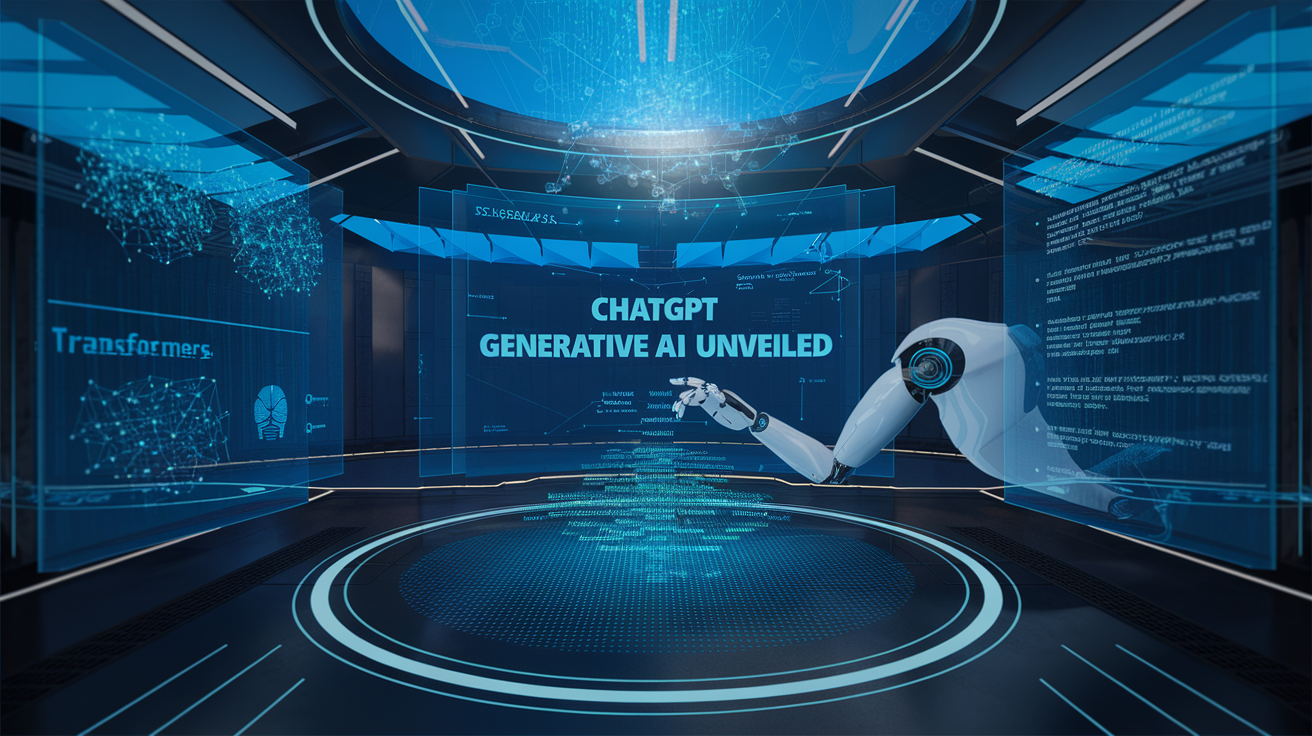Have you ever wondered how ChatGPT seems to understand and respond to your questions with such human-like precision? 🤔 This AI marvel has taken the world by storm, but for many, its inner workings remain a mystery. Generative AI is revolutionizing the way we interact with technology, and ChatGPT stands at the forefront of this digital renaissance.
Imagine having a personal assistant that can write essays, debug code, and even compose poetry – all at your fingertips. That’s the power of ChatGPT. But how does it actually work? What goes on behind the scenes to create these seemingly magical responses? From its sophisticated architecture to its intense training process, there’s a fascinating world of data and algorithms that bring ChatGPT to life.
In this blog post, we’ll pull back the curtain on ChatGPT and explore the inner workings of this groundbreaking technology. We’ll delve into the fundamentals of generative AI, examine ChatGPT’s unique architecture, uncover its rigorous training process, and reveal how it generates those uncannily human-like responses. Get ready to embark on a journey into the heart of AI innovation! 🚀
Understanding Generative AI
A. Definition and core concepts
Generative AI refers to artificial intelligence systems capable of creating new content, such as text, images, or music, based on patterns learned from existing data. At its core, generative AI utilizes complex neural networks and machine learning algorithms to understand and replicate human-like creativity.
Key concepts include:
- Neural Networks
- Deep Learning
- Natural Language Processing (NLP)
- Unsupervised Learning
| Concept | Description |
|---|---|
| Neural Networks | Interconnected layers of artificial neurons that process and transmit information |
| Deep Learning | A subset of machine learning that uses multiple layers to progressively extract higher-level features from raw input |
| NLP | The ability of AI to understand, interpret, and generate human language |
| Unsupervised Learning | AI learning from data without explicit instructions or labeled examples |
B. Key differences from traditional AI
Generative AI differs significantly from traditional AI in several ways:
- Output creation: Generative AI produces new content, while traditional AI focuses on analysis and decision-making.
- Learning approach: Generative AI often uses unsupervised or semi-supervised learning, whereas traditional AI relies more on supervised learning.
- Adaptability: Generative AI can handle a wider range of inputs and produce more diverse outputs compared to traditional AI’s more rigid, rule-based systems.
C. Applications in various industries
Generative AI has found applications across numerous industries, revolutionizing various aspects of business and creativity:
- Content Creation: Automated article writing, social media posts, and marketing copy
- Design: Generating visual concepts, logos, and product designs
- Entertainment: Creating music, scripts, and virtual characters for games and movies
- Healthcare: Assisting in drug discovery and personalized treatment plans
- Finance: Generating risk assessments and financial reports
These applications demonstrate the versatility and potential of generative AI to transform multiple sectors. As we delve deeper into the architecture of ChatGPT, we’ll see how these concepts are applied in practice to create a powerful language model.
The Architecture of ChatGPT

Neural network foundations
At the core of ChatGPT lies a sophisticated neural network, the foundation of its impressive language understanding and generation capabilities. Neural networks, inspired by the human brain, consist of interconnected nodes (neurons) organized in layers. These networks excel at processing complex data and learning intricate patterns.
Key components of neural networks in ChatGPT:
- Input layer: Receives tokenized text
- Hidden layers: Process and transform data
- Output layer: Generates probabilities for next words
| Layer Type | Function |
|---|---|
| Input | Receives data |
| Hidden | Processes information |
| Output | Produces results |
Transformer model explained
ChatGPT utilizes the Transformer architecture, a groundbreaking model in natural language processing. The Transformer model revolutionized machine learning by introducing:
- Parallel processing: Enables faster training and inference
- Long-range dependencies: Captures context over extended sequences
- Scalability: Allows for larger and more powerful models
Self-attention mechanism
The self-attention mechanism is a crucial innovation in the Transformer model, enabling ChatGPT to understand context and relationships within text. This mechanism:
- Assigns weights to different parts of the input
- Focuses on relevant information for each word
- Captures long-range dependencies efficiently
| Attention Type | Description |
|---|---|
| Self-attention | Relates different positions in a sequence |
| Multi-head attention | Allows multiple focus points simultaneously |
Training data and its importance
The quality and diversity of training data significantly impact ChatGPT’s performance. Large-scale datasets from various sources, including:
- Books
- Websites
- Articles
- Social media
These diverse sources enable ChatGPT to understand and generate human-like text across a wide range of topics and styles. The careful curation and preprocessing of this data are crucial for developing a robust and versatile language model.
Training Process of ChatGPT
Pretraining phase
The pretraining phase is the foundation of ChatGPT’s knowledge acquisition. During this stage, the model is exposed to vast amounts of text data from diverse sources, including books, articles, and websites. This process allows ChatGPT to learn language patterns, grammar, and general knowledge.
- Key aspects of pretraining:
- Unsupervised learning
- Masked language modeling
- Next sentence prediction
| Pretraining Objective | Description | Benefit |
|---|---|---|
| Masked language modeling | Predicting masked words in a sentence | Enhances contextual understanding |
| Next sentence prediction | Determining if two sentences are related | Improves coherence in responses |
Fine-tuning for specific tasks
After pretraining, ChatGPT undergoes fine-tuning to specialize in specific tasks or domains. This process involves training on carefully curated datasets relevant to the desired application.
- Fine-tuning objectives:
- Improving task-specific performance
- Adapting to domain-specific vocabulary
- Enhancing response accuracy and relevance
Reinforcement learning from human feedback
The final stage of ChatGPT’s training involves reinforcement learning from human feedback (RLHF). This process refines the model’s outputs based on human evaluations, ensuring responses are not only accurate but also safe, ethical, and aligned with human preferences.
- RLHF process steps:
- Generate multiple responses to prompts
- Human raters evaluate and rank responses
- Train a reward model based on human preferences
- Fine-tune the language model using the reward model
Now that we’ve explored ChatGPT’s training process, let’s examine how it generates responses in real-time conversations.
How ChatGPT Generates Responses
A. Tokenization of input text
Tokenization is the first crucial step in ChatGPT’s response generation process. It involves breaking down the input text into smaller units called tokens. These tokens can be words, subwords, or even individual characters, depending on the model’s vocabulary.
| Token Type | Example |
|---|---|
| Word | “hello” |
| Subword | “ing” |
| Character | “a” |
ChatGPT’s tokenizer uses a method called Byte-Pair Encoding (BPE), which efficiently handles both common and rare words. This approach allows the model to understand and process a wide range of input text effectively.
B. Contextual understanding
Once the input is tokenized, ChatGPT analyzes the context of the entire message. This involves:
- Identifying key concepts
- Recognizing relationships between words
- Assessing the overall tone and intent of the message
The model’s attention mechanism plays a crucial role in this step, allowing it to focus on relevant parts of the input while generating a response.
C. Probability-based word prediction
ChatGPT uses its vast knowledge base to predict the most likely next word in the sequence. This process involves:
- Calculating probabilities for each potential word
- Considering grammatical rules and semantic coherence
- Evaluating contextual relevance
The model’s transformer architecture enables it to process multiple words simultaneously, enhancing its prediction accuracy.





